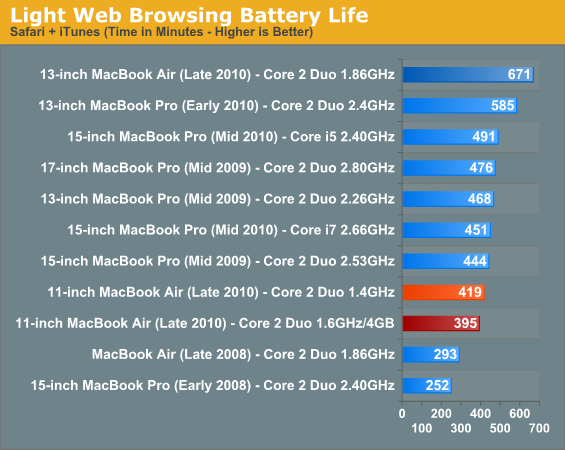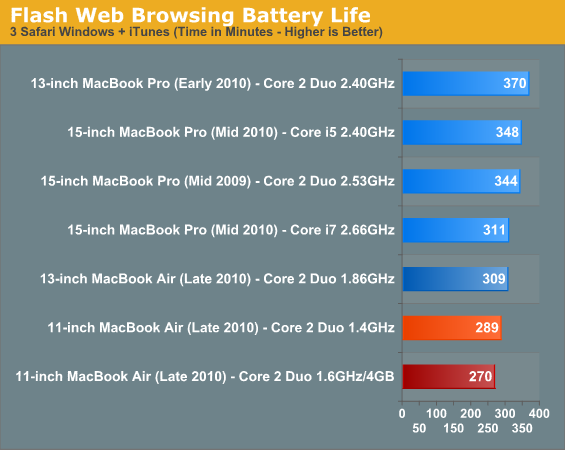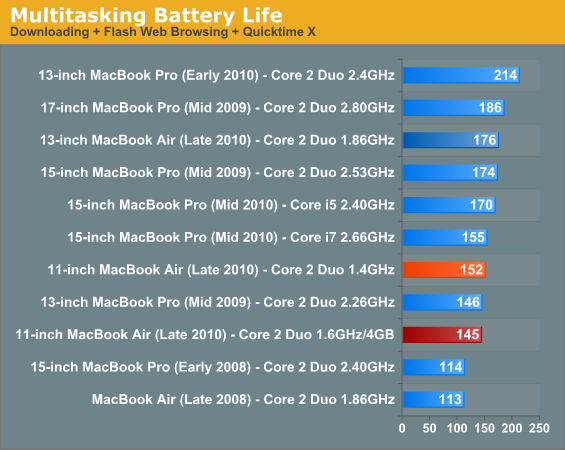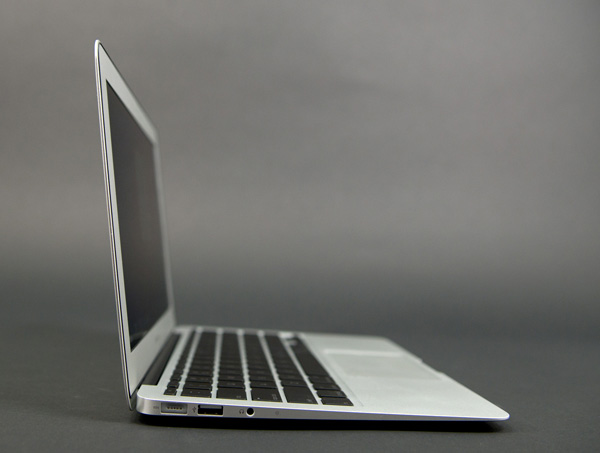Apple's 11-inch Upgraded MacBook Air: Do 1.6GHz and 4GB Make a Difference?
by Anand Lal Shimpi on November 6, 2010 2:35 AM EST- Posted in
- Mac
- Apple
- MacBook Air
- Laptops
Battery Life
Intel ships microprocessors, even those running at the same frequency, at varying voltages. Chips with lower leakage ship at lower voltages, while higher leakage chips ship at higher voltages. All CPUs have to ultimately fit within the same power envelope, but anything below that max TDP is fair game.
Running at a higher frequency generally requires a higher voltage, which in turn increases power consumption. I ran the upgraded 11-inch through all of our battery life tests to measure its impact.
Light Web Browsing
Here we're simply listing to MP3s in iTunes on repeat while browsing through a series of webpages with no flash on them. Each page forwards on to the next in the series after 20 seconds.
The display is kept at 50% brightness, all screen savers are disabled, but the hard drive/SSD is allowed to go to sleep if there's no disk activity. The wireless connection is enabled and connected to a local access point less than 20 feet away. This test represents the longest battery life you can achieve on the platform while doing minimal work. The results here are comparable to what you'd see typing a document in TextEdit or reading documents.

Flash Web Browsing
The test here has three Safari windows open, each browsing a set of web pages with between 1 - 4 animated flash ads per page, at the same time. Each page forwards onto the next after about 20 seconds.
As always, the display is set to 50% brightness, audio at two bars, screensaver disabled and the hard drive/SSD is allowed to go to sleep if idle. The wireless connection is enabled and connected to a local access point less than 20 feet away.

Multitasking Battery Life
Our final battery life test is the worst case scenario. In this test we have three open Safari windows, each browsing a set of web pages with between 1 - 4 flash ads per page, at the same time. We're also playing an XviD video in a window all while downloading files from a server at 500KB/s.

Overall the upgraded hardware resulted in a minimal impact to battery life. The worst impact was in the Flash web browsing test in which the upgraded system delivered 93% of the battery life of the base 11-inch MBA. The remaining two tests offered between 94 - 95%.
Given the 15% average improvement in performance when you need it, a 6% average reduction in battery life isn’t bad.











85 Comments
View All Comments
sprockkets - Saturday, November 6, 2010 - link
Yes, and I'm sure you have 3 different web sites open with 1-4 flash animations all the time?HTML5 animations are a power hog too. No such thing as a free lunch.
DanielATMD - Saturday, November 6, 2010 - link
Very good review.$1400 is a lot for many. But if one is going to use their computer to generate income, each model and is well worth serious consideration and should be spec'd accordingly.
Anand, I would be interested in how the MacBook Airs functions connected to a Apple Cinema Display or any other 27-30 monitor.
Right now, I have my MacBook Pro 15" connected to a 24 and a 28.5 inch LCD's, and am very interested in the MBA 11 for traveling.
Thank you.
pixelhaus - Saturday, November 6, 2010 - link
Ars Technica covered the part about using the new MBA with Apple's current 27-inch Cinema Display, it works just fine. The only weird bit is having to stretch the 3-way split cable for mini-DisplayPort, USB and MagSafe power connector; the power connector and mini-DisplayPort are on opposing sides of the MBA.Ronin48 - Saturday, November 6, 2010 - link
Can you please add a 1.4GHz 11" MacBook Air 4GB machine to this comparison?And the 1,6GHz with only 2GB RAM as well?
It would be really interesting to see how these middle-spec CTO units compare to the 1.4GHz 2GB base unit and the 1.6GHz 4GB ultimate unit that you compared here.
It's likely that one of the middle-spec units is the best performance/price/battery combination don't you think?
nitrousoxide - Saturday, November 6, 2010 - link
First I agree that this upgrade makes significant improvement compared to factory configurations, Anand gives us convincing results. It is a good deal compared to an MBA 11-inch by default, but what if compared to an MBA 13-inch which ships with a much faster CPU but $200 cheaper? Does 300 grams of weight really makes any difference in portability? Perhaps Anand is too focused on specific data, but not actual using experience. I currently use an MBA 13-inch and a SONY VAIO EA, 1.3kg and 2.3kg are exactly two different things, the MBA allows me to pack more learning material into my backpack when going to classes everyday so I just use the VAIO with i7 and discrete GPU as workstation. 1.0kg and 1.3kg, however, isn't that different, that's what I feel when I borrowed an MBA 11-inch from my friend and try to compare it to mine.blandead - Saturday, November 6, 2010 - link
you also have to remember this is for people who use macs. they are used to paying up the ass for upgrade or anything so they would know better if this is a good upgrade or not when you stay within the mac world.if you use a PC and not Mac as a majority don't even try to think what makes more sense, they don't care about $400 extra when they buy $600 ipad
hate macs....
solipsism - Saturday, November 6, 2010 - link
It’s funny that you imply the iPad expensive when all the other vendors had to go back to the drawing board and are trying desperately to match the iPad’s price point with a clearly cheaper device.khimera2000 - Sunday, November 7, 2010 - link
It takes years to divelop a product. apple just had a bigger splash with less horse power and a bigger price tag. if we wanted to match apples price point then all we have to do is put it up against a cheap android tablet. IPad and IPhone are vary simmilar in performance.it actualy looks like a step backwords in my eyes since ive seen tablet like devices in the past theres is nothing impressive about this divice. If they found a way to use a colored digital ink display in the divice then that would be intresting since it can be seen in direct sun light... near any direct sunlight.
If other companies wanted to match ipad's performance they would most certainly have to downgrade all there hardware across the board (at least for the windwos based ones)
if i where to get a tablet then it would probably be the new dell system that has a flip screen, at least then i can do work.
sprockkets - Saturday, November 6, 2010 - link
"At $1399 there's almost no way to rationally justify the price and rest assured that within 12 - 18 months Apple will have a thinner version available, likely at the same price point."T,FTFY
tehjord - Saturday, November 6, 2010 - link
Can't you overclock the 1.4ghz cpu to 1.6ghz or even more if it's safe. I mean, isn't the 1.4ghz cpu the same as the 1.6ghz cpu?So if you actually do need that extra 200mhz, just oc for the time of your workload?